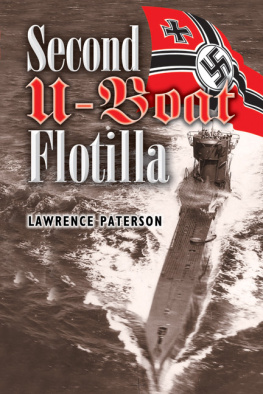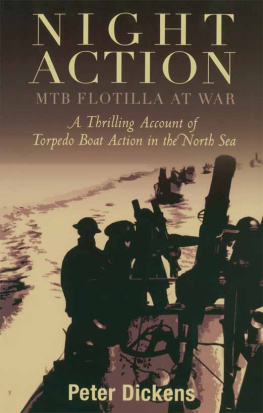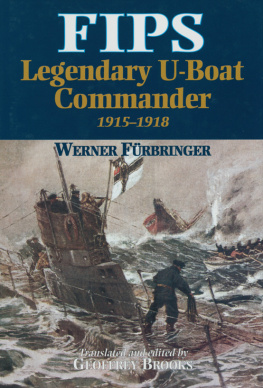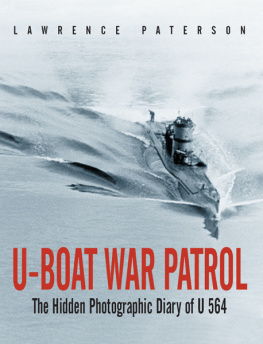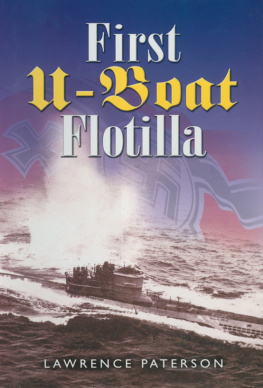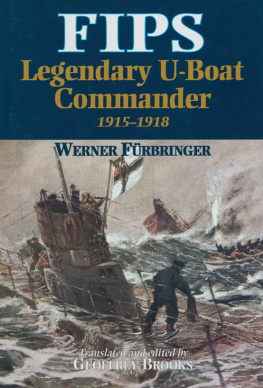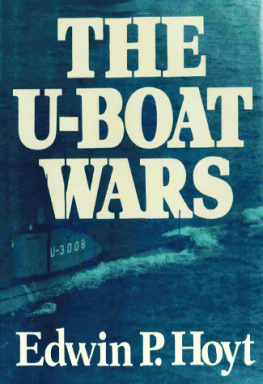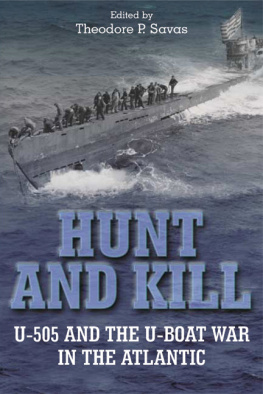
by the same Author
First U-Boat Flotilla
(Leo Cooper, 2002)

Dedicated to Bruce Shaw and Beam,
two of New Zealands finest
First Published in Great Britain 2003 by
LEO COOPER
an imprint of Pen & Sword Books Ltd
47 Church Street
Barnsley, S. Yorkshire, S70 2AS
Copyright 2003 by Lawrence Paterson
ISBN 0 85052 917 4
eISBN 978 1 78337 967 5
A CIP record for this book is available from The British Library
Typeset in 10/12pt Bembo by
Phoenix Typesetting, Burley-in-Wharfedale, West Yorkshire.
Printed by CPI UK.
ACKNOWLEDGEMENTS
Many people have helped me while writing this book and I would like to begin by thanking Sarah Paterson not least for hours of note-taking in Germany as well as Audrey, Shane, Megan, James and Ray Paterson.
Among the varied people and organizations who have provided valuable information are John Vanzo, Wolfgang Ockert, Marc Haldimann, Hans Mair, Gnther Ott, Chris Goss, Bob Cox, Lieutenant Goh RMAF, Walter Godinho, Russel Lemp, Mac McGowen, Oliver Meise, Jak Mallmann Showell, Frank James and the staff at the Lorient Naval Library. Thierry Nicolo helped enormously with his extensive knowledge of the U-boats in France. Ralf Bublitz put up with endless German translations without the slightest grumble, as did Robert Strauss. In the United States Tonya Allen aided a great deal with her meticulous proofreading, for which I am deeply grateful. From the Royal Navy Submarine Museum at Gosport, Maggie Bidmead (Head of Archives) and Debbie Corner (Head of Photographic Department) were, as always, extremely helpful with both reference material and photographs. My special thanks go to Jrgen Weber and the rest of the Mnchen U-Boot Kameradschaft for their help and patience with inexhaustible and often strange questions.
I would also like to mention Horst Bredow and Horst Schwenk of Altenbruchs priceless U-Boot Archiv. I strongly urge not only a visit to this remarkable museum, but also as much support as possible for its work.
Very special gratitude goes to the U-boat veterans who took the time to answer queries of mine in the course of writing this book, in particular Hans-Rudolf Rsing ( U35 and U48 ), Wolfgang Hirschfeld ( U109 ), Bernard Geissman ( U107 ), Fritz Weinrich ( U501 ), Volkmaar Knig ( U99 ) Ernst Gthling ( U26 ), Georg Hgel ( U30 and U110 ) and Jrgen Oesten ( U61 , U106 , U861 ).
Photographic Acknowledgements.
Hans Mair (http://www.u35.com) Plate 1; Thierry Nicolo, 30; Wolfgang Ockert, Plates, 7, 10; Royal Navy Submarine Museum, Plates 4, 5, 8, 9, 11, 21, 22, 23, 26, 27, 28, 31, 32, 33, 34; ECP Armes, 12, 16, 17, 25; Don Presley, Plate 15; Personal Collection, Plates 2, 3, 6, 13, 14, 18, 19, 20, 24, 29.
FOREWORD
The fierce war for domination of the Atlantic Ocean between 1939 and 1945 remains one of historys greatest and most terrible naval campaigns. German U-boats, mainstay of the assault on British merchant lifelines strung between the New World and the Old, continue to elicit an emotional response from both those who participated in the action and those who study and remember the bitter convoy war.
Experiences of the various U-boat flotillas involved in this battle varied widely. Combat for the 2nd U-Flotilla Saltzwedel began with an active, though covert, role in Spains brutal civil war. It was also a U-boat of the Saltzwedel Flotilla that opened Germanys naval attack against Britain on 3 September 1939. Thereafter Saltzwedel was continually involved in front-line operations. While most combat units concentrated on the crucial onslaught within the Atlantic, the 2nd U-boat Flotilla was the first to use high-endurance U-cruisers to widen the boundaries of the struggle, ranging as far as Malaya. It was this unit that launched the devastating attack on America in 1942, Operation Paukenschlag , and the extremely successful assault against rich Caribbean oil and raw material arteries only months later. Long-distance boats of the 2nd U-Flotilla were also the first to cross three oceans to the Far East and form an uneasy alliance with Japanese naval forces. Indeed, among the top ten highest scoring U-boats of the Second World War, six belonged to the 2nd U-Flotilla.
Ultimately, as Germanys fortunes faded, so too did the composition of the flotilla until it was reduced to an infantry war in trenches around the ruined shell of Lorient, France, holding out until May 1945 and the general German surrender. Any seaworthy boats had long since transferred to Norway, where, although the flotilla still existed on paper, they were distributed among other units to join the struggle for survival in seas that no longer held any sanctuary for Germanys Grey Wolves.
This book is not a day-to-day breakdown of flotilla actions, but, with extracts from War Diaries, veterans recollections and records from Germany, Great Britain, France and the United States, to name but a few, it paints a dramatic picture of the war as experienced by the 2nd U-boat Flotilla Saltzwedel.
GLOSSARY
Rank table
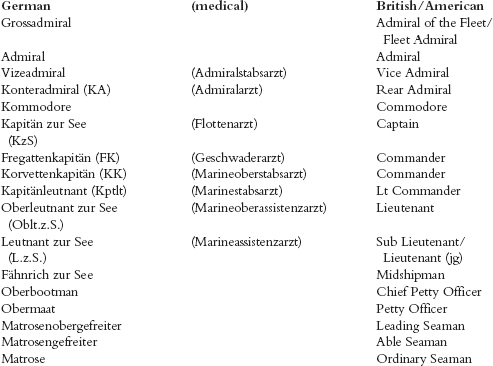
(Note: In this book German naval reserve ranks are not indicated; i.e. Oblt.d.R. is referred to as Oblt.z.S.)
Aphrodite (German) radar decoy comprising metal foil strips suspended from a helium balloon.
ASDIC term applied to the snoar equipment used for locating submarines. A powerful and effective weapon, it emitted a distinct ping when locating the target. The word ASDIC is apparently an acronym for Anti-Submarine Detection Committee, the organization that began research into this device in 1917, although some historians dispute this.
BdU (German) Befehlshaber der Unterseeboote ; Commander of all U-boats.
BdU.Ops (German) Befehlshaber der Unterseeboote Operationsabteilung ; Commander (Operations) of all U-Boats, responsible for the planning and execution of U-boat front-line activity.
BdU. Org (German) Befehlshaber der Unterseeboote Organisationsabteilung ; Commander of all aspects of logistical organization for U-boats while not at sea.
BETASOM (Italian) Italian submarine command for operations in the Atlantic. Established in Bordeaux during 1940, becoming operational in September that year and totalling 32 submarines before Italys surrender in September 1943. The name was a simple derivative of two words: B for Bordeaux and SOM as an abbreviation for Sommergibile , submarine in Italian. Within the Italian military, the letter B was indicated as Beta, thus the combination of the two created the name BETASOM.
Bold (German) Short for Kobold (goblin), an acoustic decoy, known also as the submarine bubble target, it comprised a small cylindrical mesh container filled with calcium hydride. When ejected from a submerged U-boat the compound reacted with seawater to give off hydrogen bubbles and thus a false echo to ASDIC operators. Simple but effective.
Degaussing Method of reducing the magnetic polarity inherently present around iron-hulled ships, thereby eliminating the threat of magnetic mines. This involved electrical cables carrying a strong electrical charge stretched around a ships hull that reduced or even reversed the hulls magnetic field. Merchant vessels were given temporary degaussing treatment at naval degaussing stations rather than the permanent equipment installed aboard military ships.
DF Direction Finding, homing on radio transmission.
Next page
